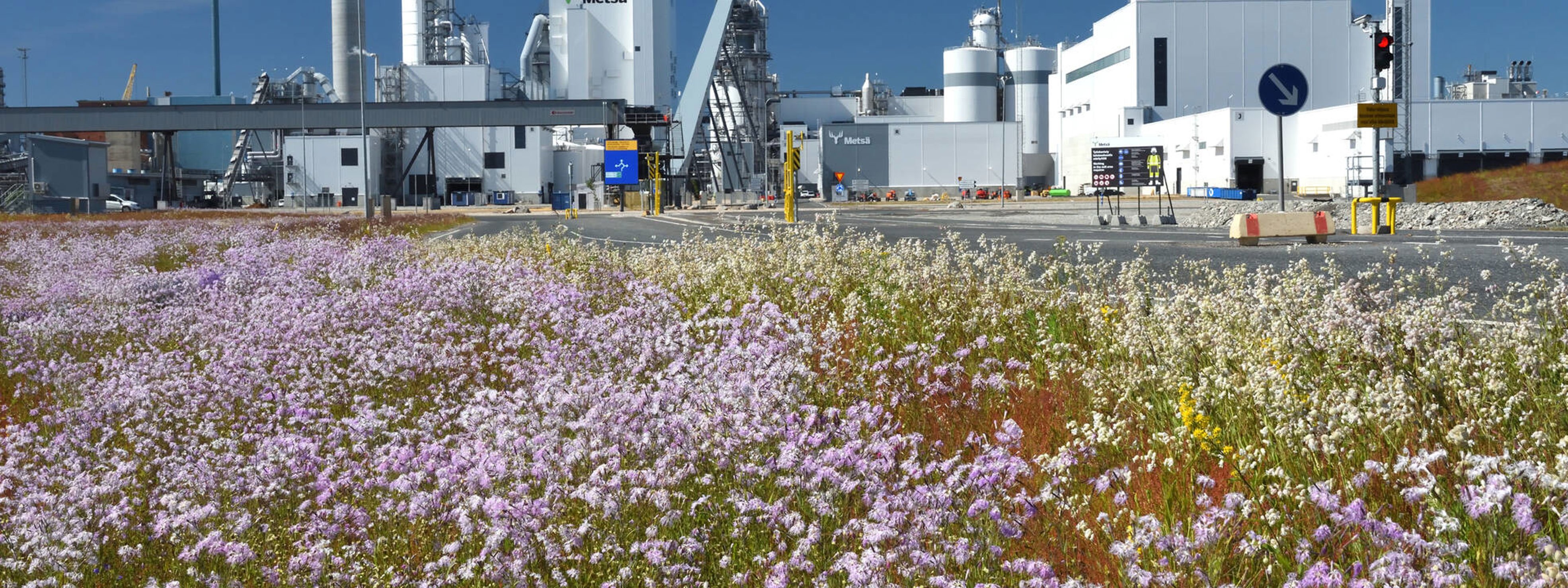Over 12 hectares of open habitats have been established in the Kemi mill area instead of lawn areas, using only local vegetation. The establishment of meadows from local species is largely manual work, but the results can be enjoyed for decades.
Efforts have been made to strengthen biodiversity in the area, by establishing meadows and sun-exposed habitats, as well as by eliminating invasive alien species and supporting endangered native species.
The establishment of habitats supports the vitality of local species, such as birds and insects. Meadows have been sown with, among other things, food plants for insects as well as regionally important and rare plant species. The seed material includes seeds from over 100 species, collected from local populations of various plant species in the Kemi area. Villivyöhyke association, which specializes in developing biodiversity in built environments, has been an important partner in the creation of these habitats.

Establishment of a meadow
The meadows established in the mill area have been sown with seeds collected from the surrounding region. The seeds were scattered by hand directly onto the growing medium. Seeds of plants that are difficult to germinate have also been cultivated into seedlings, which were then planted in the meadow. Sowing and planting are done in spring or autumn, when growing conditions are more favorable and irrigation is not needed.
In summer 2025, the meadow areas bloomed with, among others, the vibrant purple blooms of Large Pink (Dianthus superbus) and the pale-flowered Nottingham Catchfly (Silene nutans). In addition to these, the meadow has been sown with species such as Mountain Melick (Melica nutans), Wood Cow-wheat (Melampyrum nemorosum), Lady’s Bedstraw (Galium verum), and Harebell (Campanula rotundifolia).
Weed removal
The establishment of a meadow also involves the removal of weeds. Although weeds, such as Field Horsetail (Equisetum arvense) and Couch Grass (Elytrigia repens), are natural species in Finland, it is important to remove them from the meadows. Weed growth is often rapid and dense, which suppresses the most sensitive meadow plants and limits the establishment of a diverse meadow.
Fast spreading weeds are easiest to remove when creating the meadow. The above meadow has been treated with manual weeding and targeted spraying with nonanoic acid.
Supplementary sowing
Last year, supplementary sowing was carried out in the meadow using a reduced selection of species – Northern Bedstraw (Galium boreale), Lesser Stitchwort (Stellaria graminea), Wood Cranesbill (Geranium sylvaticum), and Wood Cow-wheat (Melampyrum nemorosum). This year, supplementary sowing will continue, after which the meadow is fully established, and maintenance can begin.
Meadow maintenance
Maintenance includes an annual cut and monitoring the meadow’s development. These actions are adjusted as needed depending on how the meadow evolves.
After establishment, the meadow continues to develop over several years, and a seed bank forms in the growing medium. If the area needs to be temporarily used by the factory, for example as a storage site, the meadow can regenerate once the space is freed—thanks to the seed bank in the soil. This ensures smooth factory operations despite the meadow.
Principles of regenerative land use
- Implementing solutions that maintain and enhance the native character of the local nature.
- Supporting the presence of endangered species in the built environment.
- Safeguarding the local and culture-historical importance of the site.
- Identifying and conserving species reflecting local industrial history.
- Preventing invasive alien species in line with national targets.
- Identifying and safeguarding ecosystem services in the area as municipal services.
- Creating a sense of community and working together locally.
- Supporting and developing nature solutions for environmental education.
- Combining art and culture with science-based solutions to support the natural environment.
- Innovating new approaches to the development of regenerative land use.





